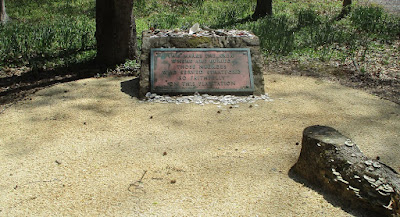Today I returned home from my undisclosed location in southeastern Virginia. Instead of driving back on mostly interstate highways, I took a more zigzag route and visited Stratford Hall, the birthplace of Robert E. Lee. It's just a few miles from the birthplace of George Washington, which I visited in March 2014, the visit being posted on this blog during that month.
The plantation's visitor center parking area was closed for reconstruction, but alternative parking had been arranged next to the gift shop, which was connected to the visitor by a bridge. Here's a view of the gift shop looking from the bridge.
A walkway leads from the gift shop toward the main house, which first takes visitors to the stables.
Here's the front of Stratford Hall's main house, with a visitor sitting on the steps. On the left is the northwest outbuilding.
Southeast of the main house is the kitchen. As with the aforementioned George Washington birthplace, and with the Stoney Baynard plantation that I saw in Hilton Head Island, South Carolina in January 2019, the kitchen was separate from the main house, to keep the slaves who worked in it out of sight.
Near the kitchen are two slave cabins, which I understand to be reconstructions built in the 1930s. This one includes a small fenced enclosure.
It took a picture of what looks like a barn. According to a sign on the opposite side, it's private residence.
From where I stood to take the picture of the "barn", I turned around and could get a shot showing both slave cabins. Each was divided into two rooms.
After seeing the slave cabins and "barn", I walked into the area behind (to the north) of the main house and came upon the octagon, named for its shape. The wall at the left ends right there. Below and behind the steps to the right is another set of steps that lead to the octagon's lower level.
This is just a small part of the east garden. If you like topiary, there's plenty of it here. I don't know what that thing is on top of the pedestal.
East of the garden is a burial vault. I don't know if anyone is buried there, but when I looked inside, its interior seemed to be run down. Robert E. Lee is buried in Lee Chapel on the campus of Washington and Lee University in Lexington, Virginia.
Everything that I've shown so far was all within walking distance of where I parked. There were a few other places within the planation that I drove to in order to see. This plaque shows the location of a slave cemetery.
Another road led me down to the south bank of the Potomac River and this mill. Its wheel and watercourse were in shade.
Next to the mill is this pond, along with some outdoor furniture.
According to some information that I've been able to gather, a politician and planter named Thomas Lee purchased the land which would become the Stratford Hall plantation in 1717. Construction started on the main house in 1738 and was completed during the 1740s. The property remained in the family until Lee's descendant Henry Lee IV sold it in 1822 to pay off his debts. Two sons of Thomas Lee, Richard Henry Lee and Francis Lightfoot Lee, signed the Declaration of Independence.
Speaking of information, to learn more, go to the Encyclopedia Virginia, The History List, American Battlefield Trust and the Potomac River Guide.













No comments:
Post a Comment